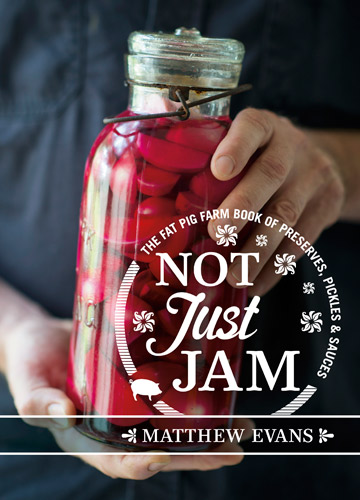Amber Marmalade
As the change of season offers the last of the summer berries and autumn’s new fruits, chef Matthew Evans’ book ‘Not Just Jam’ delivers new inspiration for home preserving.

Evans grows all his own food on his “Fat Pig Farm” in Tasmania’s Huon Valley, preserving any excess in jams, jellies and pickles.
In his latest cookbook, Not Just Jam – the Fat Pig Farm Book of Preserves, Pickles & Sauces – he takes the reader on a journey of the dos and don’ts of preserving fruit, before offering a seasonal selection of modern recipes for jams, relishes, sauces, pastes and cordials, interspersed with inspiring images of the produce and kitchen at Fat Pig Farm.
“When you live as we do, what you eat is driven by the season; by what nature gives you,” he writes.
“And, inevitably, you end up with a glut of one thing or another. This glut really is a gift. It allows you to store food, to preserve food, for leaner times.
“But this book isn’t just for those who have their own orchard. It’s for those passionate about flavour, who want to know what goes into their preserves. It’s for the freegan, those who scour the suburbs looking for fruit trees whose bounty isn’t being harvested.”
Here, Evans shares his recipe for Amber Marmalade, a mix of oranges, grapefruit and lemons preserved naturally with sugar.
Amber Marmalade
Oh yes, marmalade. A three-fruit version. That perfect blend of bitterness, tartness and sweetness. Strips of peel with just the right amount of chew. A gloriously set jelly with a smoky hue. Smothered on thickly buttered toast and eaten with a steaming mug of tea.
Ingredients
3 oranges, scrubbed gently
2 grapefruit, scrubbed gently
4 lemons, scrubbed gently
2.25kg sugar
Method
Wash and sterilise nine 300ml jars (see “Sterilisation” below).
Cut the fruit into quarters, and then cut across each quarter to make thin slices. Thinner is generally better with marmalade, though I do like a few larger strips on occasion. Put the slices in a large stainless-steel saucepan and just cover with water. Bring to the boil over high heat, then reduce to a lively simmer for about 45 minutes until the peel is tender. Remove from the heat, cover the pan and allow to stand overnight.
The next day, pour the fruit and liquid into a jam pan over medium heat. Add the sugar and stir until dissolved. Increase the heat to high and boil the marmalade for about 30 minutes. Remove from the heat then check the set. Pour into warmed jars and seal. It should keep well for up to 2 years in a cool, dark spot. Refrigerate once opened.
Sterilisation
This is the big one. In the age of refrigeration we’ve often forgotten how much mould and yeast thrive when left unchecked. You can preserve things through excluding oxygen (tight-fitting lids), introducing an acid (pickled foods), and by adding enough sugar or salt. But even then it’s important to start with really clean implements, and to store things in sterilised jars with sterile lids. So wash your storing jars or containers really well before sterilising.
Heat kills bugs, and bugs can cause your preserves to lose quality, or even go off. If you want to sterilise just one bottle, or a few jars, you can place them in a saucepan of cold water, on their sides, making sure they’re full of water and submerged. Put their lids in there, too. Bring this pot to the boil and simmer for 10 minutes. This will kill just about all the bugs you’re worried about. The only downside of this method is that it is a little tricky to take hot bottles from a pot of boiling water, though there are special tongs on the market to help you. A good thing to note is that hot sauces and jams will crack a cold jar, and this method allows you to have your jars pre-warmed ready to pour in a hot conserve.
Dishwashers, with a hot rinse cycle, also sterilise the jars, so that could be an easier method.
Be sure, when dealing with hot jars, not to put them onto a cold surface or they will crack. Always put them onto a wooden board. Cold jars will also crack if they have very hot things put in them, so warm the jars a little first, using warm water or similar.
Makes about 2.5kg.





